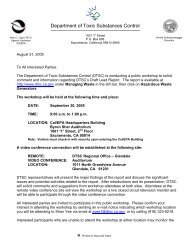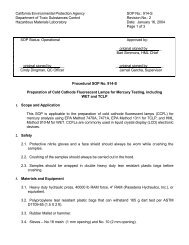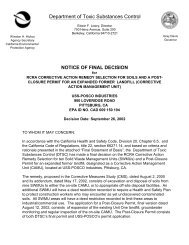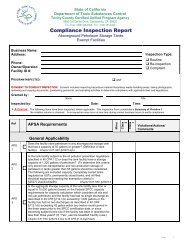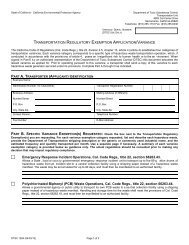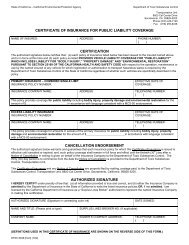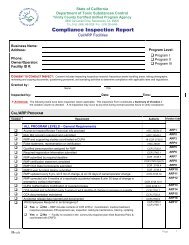Talk: Analytic Hierarchy Process/Example Leader
Talk: Analytic Hierarchy Process/Example Leader
Talk: Analytic Hierarchy Process/Example Leader
You also want an ePaper? Increase the reach of your titles
YUMPU automatically turns print PDFs into web optimized ePapers that Google loves.
<strong>Talk</strong>:<strong>Analytic</strong> <strong>Hierarchy</strong> <strong>Process</strong>/<strong>Example</strong> <strong>Leader</strong> 1<br />
<strong>Talk</strong>:<strong>Analytic</strong> <strong>Hierarchy</strong> <strong>Process</strong>/<strong>Example</strong><br />
<strong>Leader</strong><br />
This is an example showing the use of the AHP in a practical decision situation.<br />
Click HERE to return to the main article.<br />
This case study describes the use of the AHP in choosing a leader for a company whose founder is about to retire.<br />
There are several competing candidates and several competing criteria for choosing the most suitable one. By using<br />
the AHP, the Board of Directors is able to choose the best candidate in a rational, transparent way that can be<br />
examined and understood by all concerned.<br />
The diagram below shows the AHP hierarchy at the end of the decision making process. The goal is to choose the<br />
most suitable leader based on four specific criteria. Dick is the preferred alternative, with a priority of .493. He is<br />
preferred about a third more strongly than Tom, whose priority is .358, and about three times more strongly than<br />
Harry, whose priority is only .149. Experience is the most important criterion with respect to reaching the goal,<br />
followed by Charisma, Education, and Age. These factors are weighted .547, .270, .127, and .056, respectively.<br />
The balance of this article describes the derivation of these priorities.<br />
Decision scenario<br />
The company, founded in 1960, is a<br />
leading maker of specialized industrial<br />
equipment. Its future success will<br />
depend on maintaining the strength of<br />
its older product lines and on<br />
generating a constant flow of new<br />
ones. The company's founder is<br />
retiring soon, and a consulting firm has<br />
developed a detailed plan for<br />
continuing its success in his absence.<br />
The plan will take five years to<br />
implement, and will replace the<br />
founder's highly subjective "seat of the<br />
pants" style with a more carefully<br />
thought out way of doing business.<br />
The Board of Directors needs to<br />
choose someone to lead the company<br />
through the change and upheaval that<br />
implementing the consultant's plan will<br />
involve. In doing this work, the new<br />
leader will be required to make many<br />
unpopular decisions and take many<br />
unpopular actions. He or she will be<br />
expected to “clear the air” by stepping<br />
aside after the plan is fully implemented.<br />
Six months ago, the Board said:<br />
The goal of this decision is to select the most suitable leader from a field of three<br />
candidates. The factors to be considered are Experience, Education, Charisma, and Age.<br />
According to the judgments of the decision makers, Dick is the strongest candidate,<br />
followed by Tom, then Harry. Their decision process is described in depth below.
<strong>Talk</strong>:<strong>Analytic</strong> <strong>Hierarchy</strong> <strong>Process</strong>/<strong>Example</strong> <strong>Leader</strong> 2<br />
After much thought and discussion, we have identified four criteria to be used in choosing the person to guide<br />
us through the upcoming period of change: Experience, Education, Charisma and Age. Experience is<br />
important because the job requires skills and knowledge that can only be developed through practical<br />
application. And though our beloved founder was a self-made man who didn’t finish high school, the times<br />
demand that our new leader have an appropriate university education. Since the new leader will have to keep<br />
us all motivated during a difficult period of change, we prefer someone with an active, charismatic leadership<br />
style. Finally, the new leader's Age is important because he or she will need to have an appropriate career path<br />
after stepping down five years from now. — Board of Directors, Letter to Employees and Shareholders<br />
Last week, they said:<br />
After an extensive search, we have selected three candidates for this very challenging position. All are<br />
presently executives with the company. Choosing among them will be difficult, but we plan to announce our<br />
decision shortly. — Board of Directors, Followup Letter to Employees and Shareholders<br />
The three candidates are Tom, Dick, and Harry. Summaries of their backgrounds are shown below:
<strong>Talk</strong>:<strong>Analytic</strong> <strong>Hierarchy</strong> <strong>Process</strong>/<strong>Example</strong> <strong>Leader</strong> 3<br />
Decision hierarchy<br />
The AHP hierarchy for this decision is shown below. [1]<br />
As the decision makers continue with the AHP, they will determine priorities for the candidates with respect to each<br />
of the decision criteria, and priorities for each of the criteria with respect to their importance in reaching the goal. [2]<br />
The priorities will then be combined throughout the hierarchy to give an overall priority for each candidate. The<br />
candidate with the highest priority will be the most suitable Alternative, and the ratios of the candidates' priorities<br />
will indicate their relative strengths in reaching the Goal.<br />
Pairwise comparisons<br />
The priorities will be derived from a series of measurements: pairwise comparisons involving all the nodes.<br />
The nodes at each level will be compared, two by two, with respect to their contribution to the nodes above them.<br />
The results of these comparisons will be entered into a matrix which is processed mathematically to derive the<br />
priorities for all the nodes on the level. [3]<br />
The comparisons can be made in any sequence, but in this example we will begin by comparing the Alternatives<br />
with respect to their strengths in meeting each of the Criteria. Then we'll compare the Criteria with respect to their<br />
importance to reaching the Goal. [4]<br />
Since there are three Alternatives (Tom, Dick, and Harry) and we need to compare each one to each of the others, we<br />
will make three pairwise comparisons with respect to each Criterion: Tom vs. Dick, Tom vs. Harry, and Dick vs.<br />
Harry. For each comparison, the Board will first judge which member of the pair is weaker with respect to the<br />
Criterion under consideration. Then they will assign a relative weight to the other candidate.<br />
They will use the AHP Fundamental Scale in assigning the weights:
<strong>Talk</strong>:<strong>Analytic</strong> <strong>Hierarchy</strong> <strong>Process</strong>/<strong>Example</strong> <strong>Leader</strong> 4<br />
Alternatives vs. Criteria<br />
Experience<br />
Using their knowledge of the work the leader will be required to do, the Board needs to evaluate the candidates'<br />
strengths with respect to Experience. Though they have good information about each candidate's work history, there<br />
is no such thing as an objective scale for measuring "experience." Thanks to the AHP, the Board will be able to<br />
develop a scale, applying only to this one case, that measures the candidates' relative strengths with respect to<br />
experience.<br />
Here is the Board's thinking about experience:<br />
The leader will implement a wide-ranging plan that involves major changes to a successful business. This<br />
work requires skills, knowledge, wisdom, and judgment that are usually present only in seasoned executives.<br />
Furthermore, the company is so complex and specialized that only direct experience inside it can equip a<br />
prospective leader for his job. Outside experience is also important, since it provides perspective and a view of<br />
the larger picture. — Board of Directors, Internal Memorandum<br />
As a reminder, here is their summary of the candidates' experience:<br />
The next step in the AHP is to compare pairs of candidates with respect to Experience. For each comparison, the<br />
Board decides which candidate is the weaker with respect to Experience, giving his experience a weight of 1. Then,<br />
using the AHP Fundamental Scale, they assign a weight to the experience of the other candidate.
<strong>Talk</strong>:<strong>Analytic</strong> <strong>Hierarchy</strong> <strong>Process</strong>/<strong>Example</strong> <strong>Leader</strong> 5<br />
Their comparisons are summarized below. (A summary in this form is not an essential part of the AHP. It is<br />
presented here only to help readers understand this example. The colors in the squares will help them see where each<br />
entry belongs in the AHP matrix):<br />
The next step is to transfer the weights to a matrix, using a method unique to the AHP. For each pairwise<br />
comparison, the number representing the greater weight is transferred to the box of the corresponding color; the<br />
reciprocal of that number is put into the box of the color corresponding to the smaller number: [5]<br />
By processing this matrix mathematically, the AHP derives priorities for the candidates with respect to Experience.<br />
The priorities are measurements of their relative strengths, derived from the judgments of the decision makers as<br />
entered into the matrix. Mathematically speaking, they are the values in the matrix's principal right eigenvector.<br />
These values can be calculated in many ways, including by hand, or with a spreadsheet program, or by using<br />
specialized AHP software. They are shown below to the right of the matrix, along with an Inconsistency Factor<br />
computed by the specialized AHP software that was used to process the data: [6]
<strong>Talk</strong>:<strong>Analytic</strong> <strong>Hierarchy</strong> <strong>Process</strong>/<strong>Example</strong> <strong>Leader</strong> 6<br />
Education<br />
Now the Board needs to evaluate the candidates with respect to Education. Here is their thinking on the subject:<br />
The leader needs to have a good education, preferably with a recent MBA or engineering degree. Our founder<br />
is a self-made man who didn’t finish high school. He created a successful company that relies strongly on his<br />
personal insights and “seat-of-the pants” judgment. But when he retires and we move into a more complex<br />
future, we need to become more thoughtfully run. Having an educated leader is vitally important to this.<br />
Education is also important because our employees, particularly the technical staff, are hungry to have it in<br />
their leader. Though they love and respect “the Old Man,” they have often been frustrated by his lack of<br />
appreciation for today's tools of business, engineering, and manufacturing. — Board of Directors, Internal<br />
Memorandum<br />
Though a person's education can be measured by academic degrees, grades and honors, those measurements are not<br />
so useful in this non-academic situation. Through its system of pairwise comparisons, the AHP can develop accurate<br />
measurements that are perfectly suited to the decision at hand. Here is the Board's summary of the candidates'<br />
educational backgrounds:<br />
As they did previously with Experience, the Board now compares pairs of candidates with respect to Education. For<br />
each comparison, the Board decides which candidate is the weaker with respect to Education, giving his education a<br />
weight of 1. Then, using the AHP Fundamental Scale, they assign a weight to the education of the other candidate.<br />
For the sake of our example, we again provide a table summarizing their deliberations:
<strong>Talk</strong>:<strong>Analytic</strong> <strong>Hierarchy</strong> <strong>Process</strong>/<strong>Example</strong> <strong>Leader</strong> 7<br />
The Board transcribes its judgments into the AHP matrix shown below. Looking at Tom's row in the matrix, we can<br />
see that his education has three times the weight of Dick's, but only a fifth the weight of Harry's. Similar<br />
relationships can be seen in the other two rows, where Dick's education is strongly dominated by Tom's and Harry's,<br />
while Harry's education strongly dominates that of both the other men.<br />
Once again we use AHP software to derive priorities from the numbers in the AHP matrix:<br />
The priorities tell us that, according to the judgment of the decision makers, Harry's education is by far the strongest<br />
of the three. Generally speaking, it dominates Tom's by a factor of almost 4, and Dick's by a factor of 9.
<strong>Talk</strong>:<strong>Analytic</strong> <strong>Hierarchy</strong> <strong>Process</strong>/<strong>Example</strong> <strong>Leader</strong> 8<br />
Charisma<br />
The Board's next step is to pairwise compare the Alternatives (candidates) with respect to Charisma. Here's what<br />
they have to say about it:<br />
As implementation of the plan proceeds, the leader will need to overcome people’s natural resistance to<br />
change. We think he will often need to wield influence on the basis of his personal charm and appeal, rather<br />
than on talk, logic, or authority alone. We have called this charm and appeal “charisma”. It will be an important<br />
factor in the leader’s ability to implement the plan. — Board of Directors, Internal Memorandum<br />
Here is their summary of the candidates' leadership qualities:<br />
And here are their judgments about those qualities as they relate to Charisma:<br />
Putting their judgments into the matrix and processing it with the AHP software, they get:<br />
Note that even though "charisma" is a highly subjective concept with no imaginable measurement scale, the AHP has<br />
allowed the board to measure its relative strength among these three candidates. Also note that with different<br />
candidates, or even with different board members, the measurements would likely be different as well. The AHP's<br />
measurements, though accurate and produced through well-tested mathematics, apply only to the specific case at
<strong>Talk</strong>:<strong>Analytic</strong> <strong>Hierarchy</strong> <strong>Process</strong>/<strong>Example</strong> <strong>Leader</strong> 9<br />
hand.<br />
Age<br />
A person's age can be determined with a precision of days or even minutes. But such measurements aren't highly<br />
useful in making the decision at hand, since there is more to "Age" in this context than mere chronology.<br />
Also, there are U.S. laws against employment discrimination by age. Anyone using age as a decision factor must be<br />
very explicit about their reasons and justifications. In this case, it wouldn't be good if an unsuccessful candidate<br />
decided to sue the company on the basis of age discrimination.<br />
The Board has said this about Age:<br />
The leader will be expected to step down five years from now. For his benefit and ours, we need to consider<br />
how old he will be at that time. If he is at or near retirement age, he can just retire, possibly remaining with us<br />
in a consulting capacity. If he is younger, he will have more years to work, but there will likely be no place for<br />
him in our company. Based on his success as our leader, he might or might not be easily employable<br />
elsewhere. He could possibly join a competitor and take key people with him, in spite of any non-compete<br />
agreements we might negotiate.<br />
The leader's age also affects his ability to interact with our workforce. Many of the people involved with our<br />
important legacy products are over age 55. Most of those connected with our newer products are in their 20’s<br />
and 30’s. It is important that the leader is able to relate to both these age groups, and that they are able to<br />
accept his leadership. — Board of Directors, Internal Memorandum<br />
Tom, Dick, and Harry are now 50, 60, and 30 years old respectively. Here's a summary of the Board's evaluation of<br />
them with respect to Age:<br />
Transfering their judgments to an AHP matrix and processing it with software yields this result for the Alternatives<br />
with respect to Age:
<strong>Talk</strong>:<strong>Analytic</strong> <strong>Hierarchy</strong> <strong>Process</strong>/<strong>Example</strong> <strong>Leader</strong> 10<br />
Criteria vs. the Goal<br />
Now that the decision makers have evaluated the Alternatives (candidates) with respect to their strength in meeting<br />
the Criteria, they need to evaluate the Criteria with respect to their importance in reaching the goal.<br />
Once again they do this by a series of pairwise comparisons. As with the Alternatives, this part of the process<br />
requires much discussion and debate among the decision makers. [7]<br />
In this case, the Board agrees on these relative weights for the various pairs of Criteria:<br />
Note that pairwise comparison of four nodes requires six separate comparisons, while that of three nodes requires<br />
only three. [8]<br />
These comparisons require a larger matrix, but it is processed in the same way as the smaller ones. Here is the matrix<br />
for the Criteria, along with the resulting priorities and Consistency Factor:
<strong>Talk</strong>:<strong>Analytic</strong> <strong>Hierarchy</strong> <strong>Process</strong>/<strong>Example</strong> <strong>Leader</strong> 11<br />
Note that, in this decision, Experience, the highest ranked Criterion, is about twice as important in reaching the goal<br />
as the second-highest ranked Criterion, Charisma. Similarly, Charisma is about twice as important as Education,<br />
which in turn is more than twice as important as Age.<br />
Synthesizing final priorities<br />
Now that we know the priorities of the Criteria with respect to the Goal, and the priorities of the Alternatives with<br />
respect to the Criteria, we can calculate the priorities of the Alternatives with respect to the Goal. This is a<br />
straightforward matter of multiplying and adding, carried out over the whole of the hierarchy. [9]<br />
In our example, each Alternative's priority with respect to reaching the Goal is the sum of:<br />
• His priority with respect to Experience, multiplied by Experience's priority with respect to the Goal, and<br />
• His priority with respect to Education, multiplied by Education's priority with respect to the Goal, and<br />
• His priority with respect to Charisma, multiplied by Charisma's priority with respect to the Goal, and<br />
• His priority with respect to Age, multiplied by Age's priority with respect to the Goal<br />
Here are the calculations for the Candidates with respect to the Criteria:
<strong>Talk</strong>:<strong>Analytic</strong> <strong>Hierarchy</strong> <strong>Process</strong>/<strong>Example</strong> <strong>Leader</strong> 12<br />
Key: Column A shows the priority of this Alternative with respect to this Criterion. Column B shows the<br />
priority of this Criterion with respect to the Goal. Column C shows the product of the two, which is the global<br />
priority of this Alternative with respect to the Goal.<br />
Looking only at Tom, we can see that his priority with respect to the Goal is 0.358, calculated as follows:<br />
• Tom's priority with respect to Experience is 0.217 x 0.547 = 0.119, plus<br />
• Tom's priority with respect to Education is 0.188 x 0.127 = 0.024, plus<br />
• Tom's priority with respect to Charisma is 0.703 x 0.270 = 0.201, plus<br />
• Tom's priority with respect to Age is 0.265 * 0.056 = 0.015,<br />
• For a total of 0.119 + 0.024 + 0.201 + 0.015 = 0.358<br />
Here are the overall priorities for all of the Candidates:
<strong>Talk</strong>:<strong>Analytic</strong> <strong>Hierarchy</strong> <strong>Process</strong>/<strong>Example</strong> <strong>Leader</strong> 13<br />
Making the decision<br />
Based on the Board's choice of decision criteria, on their judgments about the relative importance of each, and on<br />
their judgments about each candidate with respect to each of the criteria, Dick, with a priority of 0.492, is by far the<br />
most suitable candidate. Tom, with a priority of 0.358, is second, and Harry, at 0.149, is third.<br />
The Board should choose Dick as the company's new leader.<br />
Because they have used the AHP, it is easy for them to trace their thinking and to justify the steps along the way to<br />
their decision. If they have second thoughts about the final outcome, they can revisit the process and make changes if<br />
appropriate. [10] And if they choose to, they can reveal the details of their process to their consultants and confidants,<br />
to the candidates, to the shareholders, or to anyone else who might be concerned with the decision.<br />
References<br />
Notes<br />
[1] The form and content of the hierarchy are dependent on the wants and needs of the decision makers. If the consultant's plan, for example,<br />
included moving all manufacturing to China, the board may well have added Chinese Language Skills as one of its Criteria. Also for example,<br />
if they had wanted to do so at any point in the process, they could have included Technical Education and Business Education as Subcriteria<br />
under Education, or made any other changes that they thought would be helpful in their deliberations.<br />
[2] The priorities on any level add up to 1.000, and they represent relative levels of strength or importance. If the priorities of the Criteria were<br />
Education=0.500, Experience=0.250, and Charisma and Age each=0.125, then Education would be twice as important as Experience in<br />
reaching the Goal, and four times as important as either Charisma or Age. Experience would be half as important as Education and twice as<br />
important as Charisma and Age. The actual priorities, of course, depend on the judgments input by the decision makers.<br />
[3] The mathematics underlying the AHP has been presented in many books and papers since the 1980s. A technical discussion of the subject is<br />
beyond the scope of this article, but a basic explanation for decision makers appears in Saaty (2008), Chapter 5. A much more detailed<br />
exposition is in Saaty (2006), Chapters 1 - 3.<br />
[4] For one-time decisions like this one, experienced AHP practitioners commonly work from the bottom up, first evaluating the Alternatives<br />
with respect to the Criteria, then evaluating the Criteria with respect to the Goal. Where the decision is a repetitive one, they commonly work<br />
from the top down.<br />
[5] A detailed description of the AHP matrix, including what numbers should go into which cells and why they should go there, can be found in<br />
Saaty (2008), Chapter 5. For this example, just follow the colors and everything will end up in the right place.<br />
[6] This example uses the Superdecisions AHP software throughout. Like most AHP software, it calculates an Inconsistency Factor, which is a<br />
measure of the internal consistency of the judgments entered into the matrix. It is desirable that this factor be less than 0.100. The<br />
Inconsistency Factor is further discussed in Saaty (2006), Chapter 2, especially on page 61.<br />
[7] An important aspect of the AHP is that it forces the decision makers to look closely at every aspect of the decision.<br />
[8] The number of comparisons increases very rapidly with the number of nodes compared. If C is the number of comparisons required and N is<br />
the number of nodes to be compared, C = N x (N-1)/2. The practical limit on nodes that can be compared is about eight (requiring 8 x 7 / 2 =<br />
28 comparisons). There are other reasons to keep the number of compared nodes below ten: Psychological studies show that the number of<br />
items that can be successfully held in mind for activities like this is between five and nine, and some of the math on which the AHP is based is<br />
most dependable in this range (see The Magical Number Seven, Plus or Minus Two; Saaty (2006) p. 61; and Saaty (2010), p. 109).<br />
[9] In our example, we can easily make these calculations by hand or in a spreadsheet. It can be impractical to do this in real world cases with<br />
much larger hierarchies: it's tedious to make so many calculations, and it's easy to introduce errors. Specialized AHP software programs make<br />
these calculations automatically and with a high degree of accuracy.<br />
[10] Most AHP software includes features to help in reviewing decisions. One common "what if?" feature is Sensitivity Analysis. This provides<br />
an easy way to see, usually graphically, what would happen to the final priorities if a given criterion were given a different weight. The<br />
Superdecisions software used in this example revealed that moderate changes in the weight of any criterion would have little effect on the final<br />
decision.<br />
Bibliography<br />
The Tom, Dick, and Harry example draws heavily on principles described in the books below, which are the current<br />
basic texts on the AHP. They contain detailed descriptions of the theory underlying the process, plus many examples<br />
of its use in the real world.<br />
• Saaty, Thomas L. (2006). Fundamentals of Decision Making and Priority Theory. Pittsburgh, Pennsylvania: RWS<br />
Publications. ISBN 0-9620317-6-3.
<strong>Talk</strong>:<strong>Analytic</strong> <strong>Hierarchy</strong> <strong>Process</strong>/<strong>Example</strong> <strong>Leader</strong> 14<br />
• Saaty, Thomas L. (2008). Decision Making for <strong>Leader</strong>s: The <strong>Analytic</strong> <strong>Hierarchy</strong> <strong>Process</strong> for Decisions in a<br />
Complex World. Pittsburgh, Pennsylvania: RWS Publications. ISBN 0-9620317-8-X.<br />
• Saaty, Thomas L. (2010). Principia Mathematica Decernendi: Mathematical Principles of Decision Making.<br />
Pittsburgh, Pennsylvania: RWS Publications. ISBN 978-1-888603-10-1.
Article Sources and Contributors 15<br />
Article Sources and Contributors<br />
<strong>Talk</strong>:<strong>Analytic</strong> <strong>Hierarchy</strong> <strong>Process</strong>/<strong>Example</strong> <strong>Leader</strong> Source: http://en.wikipedia.org/w/index.php?oldid=422454088 Contributors: AnotherOnymous, Birfday, Lou Sander<br />
Image Sources, Licenses and Contributors<br />
Image:AHP_TDHLeadImage.png Source: http://en.wikipedia.org/w/index.php?title=File:AHP_TDHLeadImage.png License: Public Domain Contributors: User:Lou Sander<br />
File:AHP TDHBiographies.png Source: http://en.wikipedia.org/w/index.php?title=File:AHP_TDHBiographies.png License: Public Domain Contributors: User:Lou Sander<br />
File:AHP TDH<strong>Hierarchy</strong>Basic.png Source: http://en.wikipedia.org/w/index.php?title=File:AHP_TDH<strong>Hierarchy</strong>Basic.png License: Public Domain Contributors: User:Lou Sander<br />
File:AHP TDHFundamentalScale.png Source: http://en.wikipedia.org/w/index.php?title=File:AHP_TDHFundamentalScale.png License: unknown Contributors: -<br />
File:AHP TDHExperienceRecap.png Source: http://en.wikipedia.org/w/index.php?title=File:AHP_TDHExperienceRecap.png License: Public Domain Contributors: User:Lou Sander<br />
File:AHP TDHExperienceGrid.png Source: http://en.wikipedia.org/w/index.php?title=File:AHP_TDHExperienceGrid.png License: Public Domain Contributors: User:Lou Sander<br />
File:AHP_TDHExperienceMatrix.png Source: http://en.wikipedia.org/w/index.php?title=File:AHP_TDHExperienceMatrix.png License: Public Domain Contributors: User:Lou Sander<br />
File:AHP TDHExperienceMatrixWPriorities.png Source: http://en.wikipedia.org/w/index.php?title=File:AHP_TDHExperienceMatrixWPriorities.png License: Public Domain Contributors:<br />
User:Lou Sander<br />
File:AHP TDHEducationRecap.png Source: http://en.wikipedia.org/w/index.php?title=File:AHP_TDHEducationRecap.png License: Public Domain Contributors: User:Lou Sander<br />
File:AHP TDHEducationGrid.png Source: http://en.wikipedia.org/w/index.php?title=File:AHP_TDHEducationGrid.png License: Public Domain Contributors: User:Lou Sander<br />
File:AHP_TDHEducationMatrix.png Source: http://en.wikipedia.org/w/index.php?title=File:AHP_TDHEducationMatrix.png License: Public Domain Contributors: User:Lou Sander<br />
File:AHP_TDHEducationMatrixWPriorities.png Source: http://en.wikipedia.org/w/index.php?title=File:AHP_TDHEducationMatrixWPriorities.png License: Public Domain Contributors:<br />
User:Lou Sander<br />
File:AHP TDHCharismaRecap.png Source: http://en.wikipedia.org/w/index.php?title=File:AHP_TDHCharismaRecap.png License: Public Domain Contributors: User:Lou Sander<br />
File:AHP_TDHCharismaGrid.png Source: http://en.wikipedia.org/w/index.php?title=File:AHP_TDHCharismaGrid.png License: Public Domain Contributors: User:Lou Sander<br />
File:AHP_TDHCharismaMatrixWPriorities.png Source: http://en.wikipedia.org/w/index.php?title=File:AHP_TDHCharismaMatrixWPriorities.png License: Public Domain Contributors:<br />
User:Lou Sander<br />
File:AHP_TDHAgeGrid.png Source: http://en.wikipedia.org/w/index.php?title=File:AHP_TDHAgeGrid.png License: Public Domain Contributors: User:Lou Sander<br />
File:AHP_TDHAgeMatrixWPriorities.png Source: http://en.wikipedia.org/w/index.php?title=File:AHP_TDHAgeMatrixWPriorities.png License: Public Domain Contributors: User:Lou<br />
Sander<br />
File:AHP_TDHCriteriaGrid.png Source: http://en.wikipedia.org/w/index.php?title=File:AHP_TDHCriteriaGrid.png License: Public Domain Contributors: User:Lou Sander<br />
File:AHP_TDHCriteriaMatrixWPriorities.png Source: http://en.wikipedia.org/w/index.php?title=File:AHP_TDHCriteriaMatrixWPriorities.png License: Public Domain Contributors:<br />
User:Lou Sander<br />
File:AHP_TDHCalculations1.png Source: http://en.wikipedia.org/w/index.php?title=File:AHP_TDHCalculations1.png License: Public Domain Contributors: User:Lou Sander<br />
File:AHP_TDHCalculations2.png Source: http://en.wikipedia.org/w/index.php?title=File:AHP_TDHCalculations2.png License: Public Domain Contributors: User:Lou Sander<br />
License<br />
Creative Commons Attribution-Share Alike 3.0 Unported<br />
http:/ / creativecommons. org/ licenses/ by-sa/ 3. 0/




